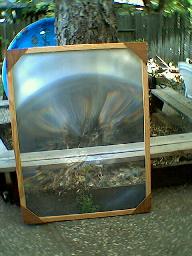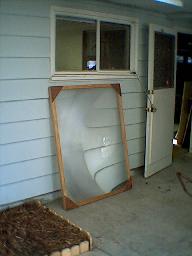Random Destructive Acts via Focused Solar Radiation
When I was a kid, I always wanted Edmund Scientific's Giant Fresnel Lens. "Melts asphalt in seconds!" the ad said. When I went to graduate school I met several other people with the same enthusiasm for aimless destruction through bizarre means, and just enough combined cash to make it happen. Thus the reign of terror began.
Unfortunately since I am now in California and the beloved Dershem Memorial Lens is still in Michigan, as is most of the, er, evidence, I can not at this time provide any images.
Things we have destroyed with the giant Fresnel lens:
- Our retinas.
This lens takes nearly a square meter of sunlight and concentrates it
into about a square centimeter. We did not have the lens for too long
before we were all seeing spots and heading to the nearest welding
supply shop. "Are you doing arc welding or gas welding?" "Neither,
actually we are destroying random inanimate objects with a giant
Fresnel lens."
- Ande's hand.
Actually a black leather glove she was wearing. Remember kids, don't
get your hand in the beam -- that glove started smoking instantly. It
seems when you are wearing #12 arc welding lenses, you can't see much
short of the sun and whatever is in the lens' focus. (Like your hand
on fire.)
- The side of someone's head.
I don't even remember who's head it was. Or maybe I won't say to save
that person embarrassment. But it was far enough from the focal point
to do too much damage. Or at least that is the claim.
- A canadian penny.
Like coupons, I think the redemption value of these is $.01 per 20, so
why not destroy it? Actually we never managed to completely destroy
it, as whatever we placed it on would perish long before the penny
would. (Which brings me to the next entry . . .) We did completely
oxidize the surface, however.
- A sidewalk.
It seems that normal concrete will start emitting plumes of smoke just
before it pops, leaving a crater about the size of a quarter, and
ejecting the aforementioned canadian penny in some random direction.
Kids, always wear safety goggles when playing with giant Fresnel
lenses.
- Lots of chalk.
Chalk actually burns under this thing.
- Aluminum cans.
So do aluminum cans. They smell really bad.
- The floor.
It is never a good idea to use the lens indoors.
- Mike's car.
Well, not yet. But it's plastic, so it would go up in no time at all.
Or maybe we could just shrink-wrap the body around the frame.
As you can see, the purchase of such a dangerous item is mostly a
self-destructive act. Be warned.
This lens takes nearly a square meter of sunlight and concentrates it into about a square centimeter. We did not have the lens for too long before we were all seeing spots and heading to the nearest welding supply shop. "Are you doing arc welding or gas welding?" "Neither, actually we are destroying random inanimate objects with a giant Fresnel lens."
Actually a black leather glove she was wearing. Remember kids, don't get your hand in the beam -- that glove started smoking instantly. It seems when you are wearing #12 arc welding lenses, you can't see much short of the sun and whatever is in the lens' focus. (Like your hand on fire.)
I don't even remember who's head it was. Or maybe I won't say to save that person embarrassment. But it was far enough from the focal point to do too much damage. Or at least that is the claim.
Like coupons, I think the redemption value of these is $.01 per 20, so why not destroy it? Actually we never managed to completely destroy it, as whatever we placed it on would perish long before the penny would. (Which brings me to the next entry . . .) We did completely oxidize the surface, however.
It seems that normal concrete will start emitting plumes of smoke just before it pops, leaving a crater about the size of a quarter, and ejecting the aforementioned canadian penny in some random direction. Kids, always wear safety goggles when playing with giant Fresnel lenses.
Chalk actually burns under this thing.
So do aluminum cans. They smell really bad.
It is never a good idea to use the lens indoors.
Well, not yet. But it's plastic, so it would go up in no time at all. Or maybe we could just shrink-wrap the body around the frame.
There are probably many more otherwise useful and productive things
which have met an untimely demise through our devious misuse of
science. The memories are hazy (probably because of the fumes from
all the burning plastic) but as they come back I will add them here.
Updated March 19, 2003:
It has been about 8 years since I wrote this page (before 2002 the
last modification date was June 30, 1995) and I still get emails about
it every few days. The most frequently asked question is, "Where
can I buy one?" Edmund Scientific quit making this rectangular
lens a few years ago and the company split, but Edmund Industrial Optics now
makes a round 35 inch diameter lens (and many smaller sizes). Last I
checked it was on this
page but that's likely to change. It was part number NT43-921:
FRESNEL LENS 35.0" DIA and cost $224.10.
Jacob Dickinson informed me that Alltronics.com sells a rectangular
lens similar in size to the infamous lens we had, and a few weeks ago
I got one (see below). It's thinner than the Edmund's lens we used to
have and needed a frame, but it's big and about half the price of
Edmund's lens. You can find it at http://www.alltronics.com/lenses.htm
and it was $99 plus shipping when I looked.
If you're looking for something smaller and a lot cheaper, you can
often find cheap surplus (used) 12" Fresnel lenses at American Science and Surplus and Scientifics (the new
owner of the Edmund Scientific Catalog) for as little as $3.
And to answer another only slightly less frequently asked question, no
the beloved Dershem Memorial Lens is not for sale. We decided
it would go to the first of us to get a Ph.D. (in other words, to
first order we left it up to fate) and Chris Chaput was the proud
winner. Thus Dr. Chris now owns the lens and (for obvious reasons) it
is kept at least 1000 miles away from him at all times.
People also ask, "What was the area of the focus?" The best we
ever got was about a centimeter across. The lens was somewhat
flexible so the corners didn't tend to contribute much. A professor
at U of M who had one of these said he built a frame with cross
supports and was able to get more of the lens to contribute to the
focus.
A lot of people want to know what temperatures we achieved.
It's hard to make this estimate, the real question should be how much
power the lens can supply (and you can see more about this below).
But in terms of estimates, we certainly melted aluminum which has a
melting point of 660.37 degC. We never quite managed to melt copper
with the old lens but (melting point of 1083.4 degC) but we have with
the new one (see below) so I think we could have if the sidewalk had
not been so fragile. Assuming a black body target and that the sun
supplies 1340 W/m^2 (before atmospheric absorption) we calculated that
we should be able to melt quartz (1610 degC) but in practice I don't
believe we achieved temperatures that high.
Here are a few pictures of our new lens
(from Alltronics.com)
and our first
test target.
The target was (certainly past tense) a zinc penny. The copper turned
into a black crust and the zinc ran out the side (that silver blob
going up in these pictures). The target stage was some shale like
rock we had sitting around, which would flake when heated but didn't
pop and eject the target.
We have since taken many targets and caused them to
melt/incinerate/explode (it's a pain to clean pop off the lens) and
soon I will add a few more pictures.
Impressive as destroying a penny may seem, I estimated that we may
have only managed to get maybe 10 percent of the available
energy hitting the lens (roughly 1kW) into the penny:
This is likely at least a slight underestimate of the lens' output for
at least a couple reasons: it was slightly cloudy and the sun was not
all that high (effective transmission may have been much lower);
likely a lot of the energy went into the stage instead of the target
(the metal stage we used later was pretty badly warped when we were
done). We hope to improve on this by making stands and will try to
measure it more carefully. This is optically a better lens than the
old Edmunds one (better image) and as Edmunds points out, optically
better Fresnel lenses tend to be less efficient light concentrators,
so maybe that's part of our problem too -- there was a nice central
focus (smaller than the penny) but a lot of the light was scattered
into a much larger area, at least a foot across. This may make the
lens more useful for diffuse heat applications (cooking) than
concentrated ones. We'll see . . .
The Random Destructive Acts FAQ
The New Lens




returN  Return
Return
Why are you here? / What does it all mean? /
bclee@umich.edu